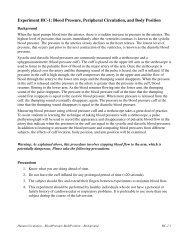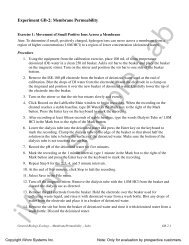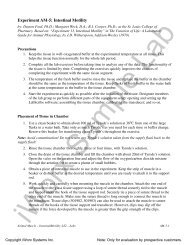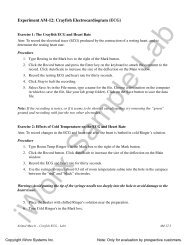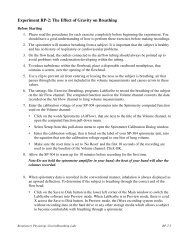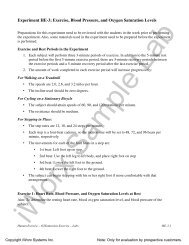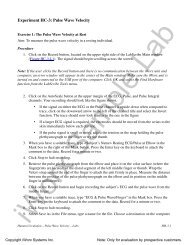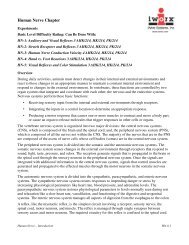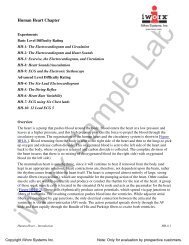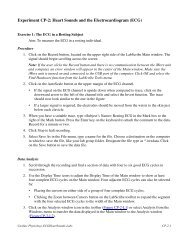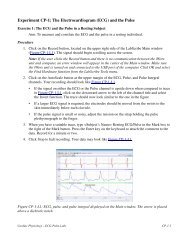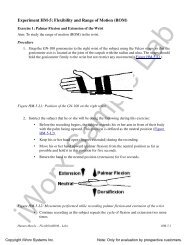Experiment HN-2: Stretch Receptors and Reflexes - iWorx
Experiment HN-2: Stretch Receptors and Reflexes - iWorx
Experiment HN-2: Stretch Receptors and Reflexes - iWorx
- No tags were found...
You also want an ePaper? Increase the reach of your titles
YUMPU automatically turns print PDFs into web optimized ePapers that Google loves.
• the black (-1) lead wire is attached to an electrode which is about 12cm from the knee.• the red (+1) lead wire is attached to an electrode which is about 10cm above the negativeelectrode.• the green (C) lead wire is attached to the electrode on the knee that functions as theground.Figure <strong>HN</strong>-2-L3: Circuit diagram for recording EMGs from the thigh muscles.4. Feel the position of the patellar tendon just below the kneecap. Place one h<strong>and</strong> on the patella(kneecap), <strong>and</strong> use the other h<strong>and</strong> to tap the patellar tendon with the reflex hammer. Find thepoint on the patellar tendon that causes the greatest response from the quadriceps muscle.5. Click Record <strong>and</strong> then instruct the subject to raise <strong>and</strong> lower his or her lower leg to demonstratethe type of EMG that occurs during quadriceps contraction <strong>and</strong> relaxation. Click AutoScale onthe EMG Quad channel. Click Stop to halt the recording6. Type Patellar Tendon Reflex in the Mark box that is to the right of the Mark button.7. Click Record. Press the Enter key on the keyboard to mark the recording.8. Instruct the subject to relax his or her quadriceps muscle <strong>and</strong> that the exercise has begun.9. Tap the subject’s patellar tendon to elicit the stretch reflex. Record a total of ten trials using thesame tapping force.10. After the tenth trial, click Stop to halt recording.11. Select Save in the File menu,12. Repeat this exercise on the same subject while the subject is voluntarily contracting his or herquadriceps.<strong>iWorx</strong> Sample LabHuman Nerve – Achilles/Patellar <strong>Stretch</strong> <strong>Receptors</strong> <strong>and</strong> <strong>Reflexes</strong> – Labs<strong>HN</strong>-2-5Copyright <strong>iWorx</strong> Systems Inc.Note: Only for evaluation by prospective customers.
13. Repeat this exercise on the same subject while the subject is performing Jendrassik’s Maneuver.To perform this muscle activity:Data Analysis• The subject should curl the fingers of each h<strong>and</strong> toward its palm form a cup-shaped grip.• The subject should hold his or her h<strong>and</strong>s <strong>and</strong> arms in front of his or her chest so thatelbows are pointed out.• The subject should interlock his or her h<strong>and</strong>s using the cup-shaped grip.• While the subject’s patellar tendon reflex is recorded, the subject attempts to pull his orher h<strong>and</strong>s apart. Jendrassik’s Maneuver is an isometric contraction, in which motoractivity that may affect reflex responses, occurs in another part of the body (the arm <strong>and</strong>shoulder muscles).1. Use the same technique explained in Exercise 1 to measure <strong>and</strong> record the conductions times ofthe subject’s patellar reflex, patellar reflex with quadriceps muscle tension, <strong>and</strong> patellar reflexwith Jendrassik’s Maneuver.2. Enter the mean reflex conduction times <strong>and</strong> velocities for this exercise in Table <strong>HN</strong>-2-L1Questions1. Compare the average reflex times of the Achilles <strong>and</strong> patellar tendon reflexes. What factorscontribute to the difference between the two reflex times?2. Is the patellar reflex inhibited or enhanced by voluntary muscle activity in the quadriceps?Speculate on the mechanism of inhibition or enhancement.3. Is the patellar reflex retarded or facilitated during the Jendrassik's Maneuver (voluntary muscleactivity an another part of the body)? Speculate on the mechanism of retardation or facilitation.4. Besides excitatory inputs from stretch receptors, what synaptic inputs might influence theactivity of spinal motorneurons?<strong>iWorx</strong> Sample LabHuman Nerve – Achilles/Patellar <strong>Stretch</strong> <strong>Receptors</strong> <strong>and</strong> <strong>Reflexes</strong> – Labs<strong>HN</strong>-2-6Copyright <strong>iWorx</strong> Systems Inc.Note: Only for evaluation by prospective customers.
Table <strong>HN</strong>-2-L1: Reflex Conduction Times <strong>and</strong> Velocities for Achilles <strong>and</strong> Patellar Tendon<strong>Reflexes</strong>.ReflexAchilles Tendon - Light TapAchilles Tendon - Medium TapAchilles Tendon - Heavy TapPatellar Tendon - QuadricepsRelaxedPatellar Tendon - QuadricepsTensedPatellar Tendon - Jendrassik’sManeuverAppendixUsing the PRH-100 Patellar Reflex HammerMean Reflex Conduction Time(ms)Reflex Conduction Velocity(m/s)As an alternative to using the PT-104 <strong>and</strong> a reflex hammer, these exercises can be performed using thePRH-100 Patellar Reflex Hammer.1. Locate the PRH-100 Patellar Reflex Hammer <strong>and</strong> plug the BNC connector into Channel 2 ofthe IWX/214 or into Channel A3 of the IXTA.2. On the menu toolbar, click Edit, Preferences.3. The Channel window will be displayed.• Uncheck Channel 3 (IWX/214) or Channel A5 (IXTA)• Put a “check mark” in the Box next to Channel 2 (IWX/214) or Channel A3 (IXTA)• Type Tendon Tap in the Title column associated with the new channel.• Click OK.4. The lab settings are now ready to use with the PRH-100 Patellar Reflex Hammer. You can beginrecording following the directions in the lab exercises.<strong>iWorx</strong> Sample LabHuman Nerve – Achilles/Patellar <strong>Stretch</strong> <strong>Receptors</strong> <strong>and</strong> <strong>Reflexes</strong> – Labs<strong>HN</strong>-2-7Copyright <strong>iWorx</strong> Systems Inc.Note: Only for evaluation by prospective customers.



